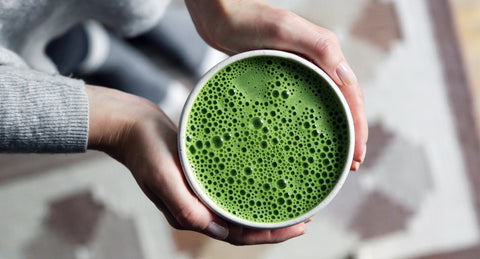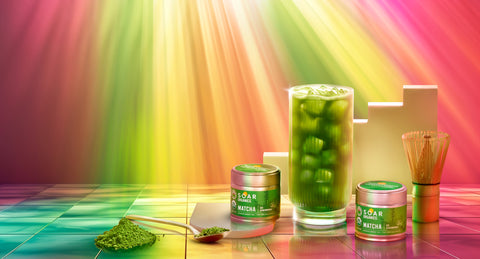Matcha green tea, a finely ground powder of specially grown and processed green tea leaves, has been celebrated for centuries in traditional Japanese tea ceremonies. Its vibrant green color and distinct taste set it apart from other green teas, but what truly makes matcha a superfood are its potent catechins, particularly epigallocatechin gallate (EGCG). This blog post will delve into the catechins in matcha, focusing on EGCG and its scientifically proven benefits.
What are Catechins?
Catechins are a type of natural phenol and antioxidant found in various plants, including tea. They belong to the flavonoid family, which is renowned for its health-promoting properties. The primary catechins found in matcha green tea include:
- Epigallocatechin Gallate (EGCG)
- Epicatechin Gallate (ECG)
- Epigallocatechin (EGC)
- Epicatechin (EC)
Among these, EGCG is the most abundant and potent catechin in matcha green tea, contributing significantly to its health benefits.
Chemical Structure and Properties
EGCG, or epigallocatechin gallate, is a type of catechin with a complex structure that includes multiple hydroxyl groups. These hydroxyl groups allow EGCG to scavenge free radicals effectively, thus providing robust antioxidant activity. This ability to neutralize free radicals helps prevent cellular damage and inflammation, which are underlying factors in many chronic diseases.
Health Benefits of EGCG
1. Antioxidant Powerhouse
EGCG is known for its powerful antioxidant properties. Antioxidants are crucial in protecting cells from damage caused by free radicals—unstable molecules that can cause oxidative stress. Oxidative stress has been linked to aging and various diseases, including cancer and cardiovascular diseases. Studies have shown that EGCG is more effective than vitamins C and E in combating oxidative stress.
2. Cardiovascular Health
EGCG has been shown to have a positive impact on heart health. It helps reduce LDL cholesterol levels, improve blood vessel function, and lower blood pressure. A study in the American Journal of Clinical Nutrition revealed that participants who consumed green tea rich in EGCG had significantly lower levels of LDL cholesterol. Additionally, EGCG's anti-inflammatory properties help reduce the risk of atherosclerosis, a condition characterized by the hardening of the arteries.
3. Weight Management
EGCG may aid in weight loss and weight management. It can boost metabolism and increase fat oxidation, making it easier to burn fat. Research published in the International Journal of Obesity found that EGCG can enhance thermogenesis (the body's rate of burning calories) and fat oxidation, contributing to weight loss and maintenance.
4. Brain Health
EGCG also supports brain health by protecting neurons and improving cognitive function. Studies suggest that it can cross the blood-brain barrier and exert neuroprotective effects. Research in the Journal of Nutritional Biochemistry indicated that EGCG can reduce the risk of neurodegenerative diseases such as Alzheimer's and Parkinson's by reducing oxidative stress and inflammation in the brain.
5. Diabetes Management
EGCG may play a role in managing diabetes by improving insulin sensitivity and regulating blood glucose levels. A study in the Journal of Agricultural and Food Chemistry found that EGCG can enhance insulin activity, making it beneficial for individuals with type 2 diabetes or those at risk.
For more matcha benefits see post: 6 Science-Backed Health Benefits of Matcha Green Tea
Other Catechins in Matcha Green Tea
While EGCG is the most researched and potent catechin, other catechins in matcha green tea also contribute to its health benefits:
- Epicatechin Gallate (ECG): Similar to EGCG, ECG has strong antioxidant properties and supports cardiovascular health.
- Epigallocatechin (EGC): EGC is known for its antimicrobial and antiviral properties.
- Epicatechin (EC): EC helps improve cardiovascular health and has been shown to have anti-inflammatory and antioxidant effects.
How to Maximize Catechin Intake from Matcha
To fully reap the benefits of catechins in matcha green tea, consider the following tips:
- Quality Matters: Choose high quality Ceremonial Matcha or Everyday Matcha. Higher grade matcha tends to have a higher concentration of catechins.
- Proper Preparation: Avoid using boiling water, as it can degrade catechins. Instead, use water that is around 70-80°C (158-176°F).
- Regular Consumption: Consistent daily consumption of matcha green tea can help maintain high levels of catechins in your body.
Conclusion
Matcha green tea is a rich source of catechins, particularly EGCG, which offers a plethora of health benefits, from antioxidant protection to cardiovascular support and weight management. By incorporating matcha into your daily routine, you can harness the power of these potent compounds to enhance your overall health and well-being. Whether enjoyed traditionally in a tea ceremony or added to smoothies and recipes, matcha provides a delicious and effective way to boost your intake of beneficial catechins.



